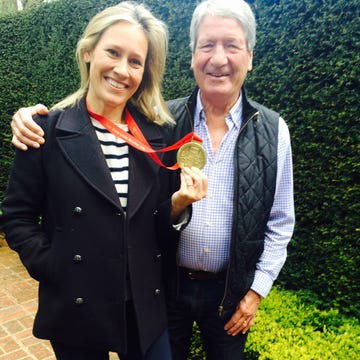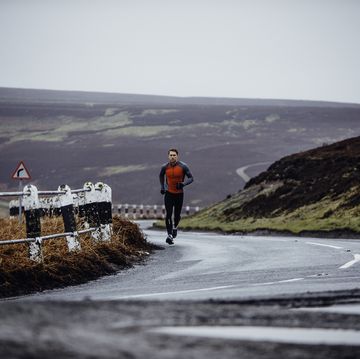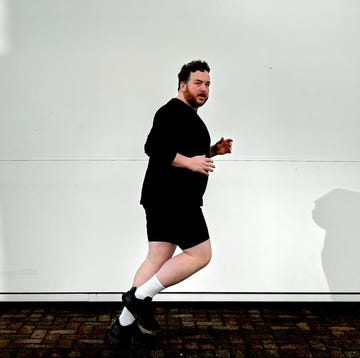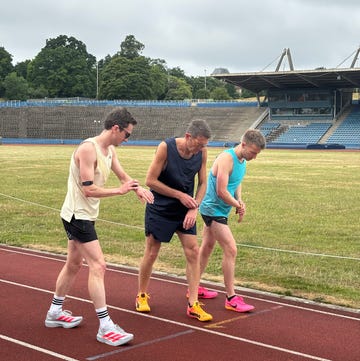As a highly promising young runner, Steve Magness fully embraced the 'no pain, no gain' philosophy on mental toughness.
But he learned from bitter personal experience that steeling yourself to push through the pain barrier isn’t always the right psychological strategy when he collapsed during a tough training session. Fast-forward 15 years and Magness has become a globally renowned performance coach, who has worked with elite athletes and Olympians. He’s also a celebrated author whose books – including Peak Performance and The Science Of Running – have sold more than half a million copies worldwide. One of sport’s foremost scientific thinkers, Magness has spent the past five years studying resilience, leading him to an enlightened re-examination of the role of mental strength in performance in his latest book, Do Hard Things – a ‘must-read’ according to runner and author Malcolm Gladwell. He sat down with RW to explore why we’ve been getting mental strength wrong, what true toughness actually looks like and how you can apply it to take your running to the next level.
Runner’s World: What motivated you to write your new book?
Steve Magness: ‘I think we write the books that we need, on the subjects that we’re wrestling with. As a lifelong runner, I’ve always wrestled with the idea of toughness, because what is running except being alone in your head and fighting those demons that tell you to slow down or drop out? So I’ve always had this in the back of my mind and what I was seeing in the wider picture is that the view we took in running on navigating these difficult moments was in reality often little better than the common concept of put your head down, push through, ignore all the pain and suffering, grit your teeth and get through it. My experience as a runner was that sometimes I needed to do that, but often I’d try that and it would fail miserably. So it was a topic I’d been wrestling with in the back of my head for years and I just thought it was time to try to bring some clarity to it.’
What everyone's reading
RW: Where do you think that idea of mental strength – the get your head down, no pain, no gain philosophy – emanates from?
SM: ‘I went down a long and winding path to try to answer that question, and the best answer I can get to is that it has its roots in a military mindset. You can trace it all the way back in the military ethos, but I think we saw the idea really flourishing after the Second World War. All of a sudden you had these ordinary people who got drafted into the military, put through bootcamp and had to get ready for some extreme situations very quickly. It’s not as if they had years to train – or even months – it was train them up, then throw them into the war. I think we got a conceptualisation of that being the way to get tough really quickly. And then in sporting culture, most of the athletics coaches had been involved in the war. When they came home and became the PE teachers and coaches of the era, they brought that military experience and attitude back with them. So this military short-term mindset kind of infiltrated and took over athletics. In fact, in the 1950s and 60s all the sporting metaphors started to change towards war. You know, “We’re going to war today!” and that kind of thing.
RW: Was this a philosophy you followed early in your running career? And if so what did you feel the consequences were from taking that approach?
SM: ‘Yes, absolutely. Like anyone, I thought that was the way – the put your head down, grit your teeth and grind through it approach. It works to a degree, but the consequences come when it doesn’t work. And it’s not going to work all the time, because it puts you in a situation where if you don’t run a PB or you don’t run as well as you want on every run, you question, “Am I not tough enough?” You start thinking that maybe you’re mentally weak. You “fail” and see it as a reflection on your mental ability, which can lead to some striking psychological and also physiological consequences. It’s almost like you’re training your brain to have just one tool. If all you have is a hammer, then of course the hammer works when you have a nail in front of you, but as we runners know well, situations can vary significantly and we’re not always going to get a “nail”. Sometimes we’re going to need a screwdriver, a saw or whatever is necessary to get through a particular kind of difficult situation. And if we think the hammer is the only solution, then more often than not, we’re going to get frustrated and struggle.’
RW: In your book, you say that your emotions are messengers, not dictators. Can you tell us what you mean by that?
SM: ‘We often think of emotion as something that we should push away, right? You know, push away the pain. In America, we have this famous saying: no crying in baseball. It’s all about never showing your emotions, but it turns out that’s a complete misunderstanding of the science and psychology of emotions. Emotions and feelings are essentially messengers. They’re signals to our conscious awareness that, hey, something is going on, something is interesting. That could be interesting in a good way or a bad way, but they’re essentially saying, “Hey! Pay attention to this thing!” They’re drawing your attention to something that’s a little different from normal that you might need to be aware of. It’s like the warning lights on a car dashboard or in a pilot’s cockpit. And if we ignore those signals, then we’re ignoring our bodies’ communication system. It’s not saying “slow down”, “stop” or “you’re in danger”. What it’s saying is simply, “There’s something to pay attention to.” Let me give you the running example: fatigue is essentially an emotion, so if we’re running a marathon and we start to experience the kind of fatigue that feels like you’re running out of fuel, what that’s actually telling us is that if we ignore it and think, “Just tough it out and get through it,” then we’re probably going to bonk. If we listen to the messenger instead of pushing it away, if we think, “I’m getting a signal that I’m running a bit low, so I’m going to take a sip of a gel or sports drink and get some calories,” more often than not, that feeling will ease a little. It may not go away completely, but your brain will process it as the signal has been heard, fuel has been taken on, so we can keep going at this pace.’
RW: There’s a famous quote that says running is about winning the conversation with the part of you that wants to quit. Is there a way to have a more nuanced conversation with that voice in your head, rather than simply trampling it down?
SM: ‘Another way to deal with it is to change how you talk to yourself. One of the things that we know from research is that whenever that negative voice comes in, we actually change how we talk to ourselves. It’s always along the lines of, “Why am I a failure?” and “I can’t do this.” It’s all first person, and research and psychology shows that when you talk in the first person your brain interprets it as being more personal and amplifies the negative emotional experience that comes with it. On the flip side, if you talk in the second or third person, it actually creates what psychologists call psychological distance. It decreases that emotional attachment to the voice and it allows us to feel more positive and do something about it. If I’m running and that internal voice is saying, “Come on, Steve, you can do this,” my brain interprets it a little bit differently and is more likely to listen to that positive voice than go down a spiral towards negativity. So, sometimes just changing how you talk to yourself can have a big effect.’
RW: What would be an example of old-fashioned mental strength and what would be an example of true mental strength?
SM: ‘I think the old-fashioned way is a lot of external, meaning you’re putting on a show, that you have false bravado. We all know it and we all do it sometimes – you’re that person who’s projecting that maybe if you act really confident and talk a big game, then it won’t be a big deal. And what the research shows – and what this new science of mental toughness shows – is that often that just sets us up for failure because of how it sets our own expectations. If you go into your first 5K or your first after a long lay-off convincing yourself that it’s going to be a piece of cake, with a mindset of this false bravado, then when it inevitably gets difficult, your brain overreacts. It’s almost like it says, “Hey, wait a minute… you told us this was going to be a piece of cake but now I’m feeling the difficulty,” and your brain freaks out. Even if you’re an experienced runner, you can go through this. I did not too long ago, when I was coming back from a long bout of injury. My brain was going with the old Steve, the fit Steve, where it was thinking, “Okay, going out and doing this moderate workout isn’t a big deal.” But because I’d been off for so long, the reality was that it was going to be much more difficult than I thought it would be. That mismatch between perception and reality sets you up to freak out. So the new idea of toughness is, instead of this external false bravado, it’s more the internal acceptance of the reality of the situation – thinking how difficult might this really be? How fit am I actually? What kind of capabilities do I have right now? You want that match, that alignment between perception and reality instead of the kind of false bravado that we’re taught.’
RW: The spectre of the DNF is often in runners’ minds as the ultimate failure. Do you think bailing on a race or any run is a sign of mental weakness? Or are we back in the realm of ego?
SM: ‘What really brought clarity to that question for me was when I was talking to some world-class climbers and they were discussing what the toughest part of climbing something like Mount Everest or K2 is. I’ve never done anything like that, so I had no idea. They told me it’s when you’re getting close to the summit, it’s when you’re maybe just a couple of hundred metres or a couple of hours away and you see it and you think, “Here’s the goal that I’ve been training my whole life for, that I’ve poured tens of thousands of dollars into…” and it’s within reach. But in that moment you have to pause and ask yourself, “Can I make it not only to the top, but turn around and make it all the way to the bottom?” And often the answer to that question is no, you can’t, because a large majority of accidents happen in that zone when climbers have made it to the top and are coming back down and simply don’t have the energy to do so. In that situation, the really tough decision to make is to quit, to turn around, to be able to pause and say, “I don’t have the energy, so I need to get out of here to live and climb another day.” In running, although it’s not life or death, we often demonise the bailing on the workout, the quitting of the race, but the reality is that it’s closer to the climbing example. If there’s a logical reason for it, where you’re maybe saving yourself for another day, or there’s a potential injury coming or you’re under the weather and you shouldn’t finish this particular workout because it’s just going to dig you into a hole that’s going to set you back more than push you forwards, those are the moments when we need to put our ego aside and say, “It’s just not my day today.”’
RW: So quitting can sometimes show the right kind of toughness?
SM: ‘It’s about getting the balance right. We don’t want to just say, “Quit whenever you feel like it,” but like those climbers, you want to be able to make that wise decision in the moment when sometimes the better choice is to quit. I think that elite marathoners actually do this a little bit better than most of us. Of course, they have an incredible capacity to tough it out sometimes, but then sometimes they’re able to recognise and accept that it’s not their day. As it’s their career, they’re able to process the fact that if they’re falling apart at mile 15, although they could tough it out and finish, that would probably mean not being able to run another good marathon for six months, so it’s not worth it. But maybe if they drop out at 15 miles, they’ll be able to come back stronger in another marathon in two months’ time, with a better effort and a better payday and all that good stuff.’
RW: Do you think the same issues with ego and that old-school perception of mental toughness also play a role in people not doing their easy runs at a genuinely easy pace, and pushing too much of their training into that middle zone?
SM: ‘When we run too hard on our easy days, it’s all insecurity. There’s a wonderful story that I tell in the book about an American marathon runner back in the 1950s called Buddy Edelen. He set the world record in the marathon, so he was at the very pinnacle of the sport, but what was fascinating was the correspondence back and forth with his coach after Edelen had run what was supposed to be an easy run both too long and too fast in the build-up to a race. And his coach wrote back to say, “This is a manifestation of uncertainty. There is a time to rest, not halfway rest.” So here was this world-class runner – the marathon world record holder – and even he was struggling with that nagging voice telling him that maybe he would lose fitness if he didn’t run this run long enough or fast enough before going into his race. And the coach was saying to him, “This is just insecurity. You’re fit. All you can do is get in your own way. And you’re getting in your own way here.”
I think we often see that insecurity with everyone from novices to experienced runners coming into play on that recovery run, that easy run, that run where we’re supposed to be disciplined and keep the effort low. We know the plan but we get a little insecure and think that maybe we shouldn’t be letting ourselves off so easily, that maybe we could squeeze a little more fitness if we run this a bit faster or that little bit longer. We end up deviating from what’s best for us because that voice in our head is telling us to just push a little bit more, push a little bit harder, when the reality is if we have the mental strength to ignore the voice and stick to the plan, we would be fitter and faster in the end.’
Keep up with the latest from Steve Magness on Twitter and Instagram (@stevemagness), or head over to stevemagness.com. Do Hard Things: Why We Get Resilience Wrong And The Surprising Science Of Real Toughness (£20, Harper Collins) by Steve Magness is available now.













